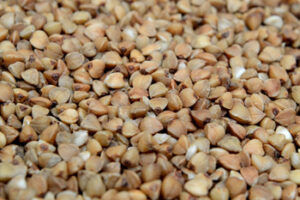Buckwheat Description & Health Benefits
 Buckwheat is a member of the Polygonaceae botanical family, which also includes rhubarb.
Buckwheat is a member of the Polygonaceae botanical family, which also includes rhubarb.- As a seed, buckwheat is considered a pseudo grain just like quinoa and amaranth. Pseudo grains are used similarly to grains, have similar nutritional profiles to grains and tend to be categorized with grains.
- Despite its conflicting name, buckwheat is naturally gluten-free.
- Buckwheat is an excellent source of fiber, riboflavin, niacin, magnesium, phosphorus, copper and manganese.
- Fiber supports digestion by preventing constipation and reducing cholesterol. It helps you to feel full faster which may help to control weight.
- Riboflavin is vital for growth and red blood cell formation.
- Niacin supports skin, nerve and digestive function and aids in the conversion of food to energy.
- Magnesium normalizes muscle and nerve function, blood sugar levels and blood pressure.
- Phosphorus contributes to the formation of bones and teeth and is needed for growth, maintenance and repair of cells and tissues.
- Copper functions with iron to help the body form red blood cells while also aiding in keeping blood vessels, nerves, the immune system and bones healthy.
- Manganese promotes formation of connective tissues, bones and blood clotting factors and is essential for normal brain and nerve function.
Purchasing, Selecting, Storing, and Preparing
- Purchase buckwheat in grocery stores or online all year.
- Select buckwheat in tightly sealed packaging within the “sell by” date. If purchasing from a bulk container, ensure the store has a fast turnover rate to get the freshest product available. Avoid purchasing buckwheat that has a musty or rancid smell.
- Store in an airtight container and keep out of direct sunlight, heat and moisture.
- Buckwheat will keep two months in the pantry or four months in the freezer.
- To prepare buckwheat, first rinse in cold water to remove any debris.
- Toast buckwheat in a dry skillet over medium heat, stirring often, until golden brown to bring out its nutty aroma. Add buckwheat to boiling water, a ratio of one part grain to two parts water, and simmer for 15 minutes in a covered saucepan. Remove from heat and let it sit in the covered saucepan for another 15 minutes to absorb more water. Fluff buckwheat and add to your dish.
- Eat buckwheat kernels, also known as groats, solo, add to vegetables as a side dish or toss in a salad. Use buckwheat flour to make any gluten-free baked good or try soba noodles made from buckwheat flour.
- Check soba noodle ingredients as wheat flour is sometimes used in some brands.
Nutrition Facts
Buckwheat groats, roasted, cooked, 1/2 cup serving
Calories: 77 | Protein: 2.84 g | Fat: 0.52 g | Carbohydrate: 16.75 g | Fiber: 2.3 g | Calcium: 6 mg | Iron: 25.2 mg | Magnesium: 43 mg | Potassium: 74 mg | Folate: 12 μg
ndb.nal.usda.gov
Recipes
Request an Appointment
